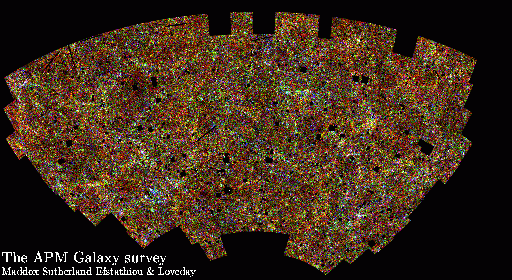
The APM Galaxy Survey contains positions, magnitudes, sizes and shapes for about 3 million galaxies selected from UKST survey plates which were scanned using the APM Facility.
UKST Plates
All of the southern sky has been photographed by the UKST using the Kodak III-aJ emulsion with a wide blue pass-band, bJ. The magnitude limit for a bJ survey plate is typically bJ=22. Much of the southern sky has also been photographed by the UKST using III-aF emulsion and a red filter, R.
APM Scans
Most of the UKST survey plates have been scanned by the APM, which provides a list of images detected on each plate, and gives the coordinates, magnitude and shape parameters for each image. Both stars and galaxies are included in the image lists and each image is classified as a star, galaxy or blended image according to the measured shape parameters.
The R and bJ data from the APM scans have been combined with similar data from the Palomar O and E plates to give a catalogue covering most of the sky. The data is available by using the APMCAT form interface.
The APM Galaxy Survey
The initial APM Galaxy Survey is based on a subset of the APM catalogues, restricted to 185 high galactic latitude UKST fields with centres Dec<-20o in the southern galactic cap. This data was processed in a different way to the APMCAT data, with the aim of producing the most uniform and reliable galaxy catalogue from the APM scans.
Since the initial 185 field survey, the coverage of the APM galaxy survey has been extended to cover the equatorial sgp area between Dec=+2.5o and Dec=-17.5o, and also the equatorial ngp area between Dec=+2.5o and Dec=-7.5o. The total area covered is now over 7000 square degrees, roughly a quarter of the whole sky.